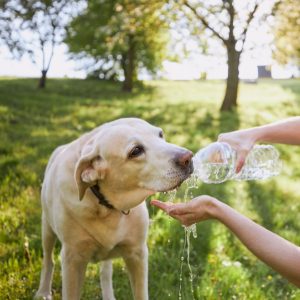 How do you protect pets from summer heat?
How do you protect pets from summer heat?
Unlike people, dogs and cats do not have sweat glands in their skin and therefore cannot cool by perspiration and evaporation. Panting is their only way for cooling off. As temperatures and humidity rise, this method becomes less efficient. Dogs and cats have a baseline body temperature of 100 to 102 degrees, and their organs begin to shut down at 106 degrees.
So how do we protect our pets from the summer heat and keep them safe and cool:
Don’t keep your pets in parked cars. Research from San Francisco State University suggests that in 10 minutes, the temperature inside a car rises by 19 degrees. After 30 minutes it goes up 34 degrees; and after an hour, the temperature soars by 43 degrees.
Be careful with high-risk dogs. Animals cool by panting, and those that can’t breathe particularly well have the highest risk for health problems during the summer. This includes brachycephalic dogs or those that have a short snout or are flat-faced – like bulldogs and pugs. Pay special attention to seniors and overweight pets, too. If your pet ever breathes in and out in a noisy way, he may have some trouble with airflow, which in turn means he may have a harder time cooling off.
Provide shade and plenty of cool, freshwater. Ice cubes in the water bowl work well. Many pets also like to say cool in a kiddie pool or sprinkler. If you use a hose to cool off your pet, be certain to run the water until it is cold. Hot water from a hose sitting in the sun can severely scald and burn your pet.
Beware of heatstroke. It’s more common in dogs than cats and often arises when exercising in hot weather. Walk your dog early in the morning or late in the evening when it is cooler. Check the temperature of the pavement using the 5-second rule. Lay the back of your hand on the road. If you cannot hold it there for 5 seconds, then it is too hot to walk your dog. Keep your pets inside during the hottest time of the day, between 10 am and 5 pm. Remember if it is too hot for you to be out it is too hot for your pet and their fur coat. Signs of heatstroke include heavy panting, glazed eyes, a rapid heartbeat, difficulty breathing, excessive thirst, lethargy, fever, dizziness, lack of coordination, profuse salivation, vomiting, a deep red or purple tongue, seizure, and unconsciousness.
If you suspect your pet may be suffering from heatstroke:
- Move your pet into the shade or an air-conditioned area.
- Apply ice packs or cold towels to her head, neck, and chest or run cool (not cold) water over her.
- Let her drink small amounts of cool water or lick ice cubes.
- Take her directly to a veterinarian.
Source: Nutrena